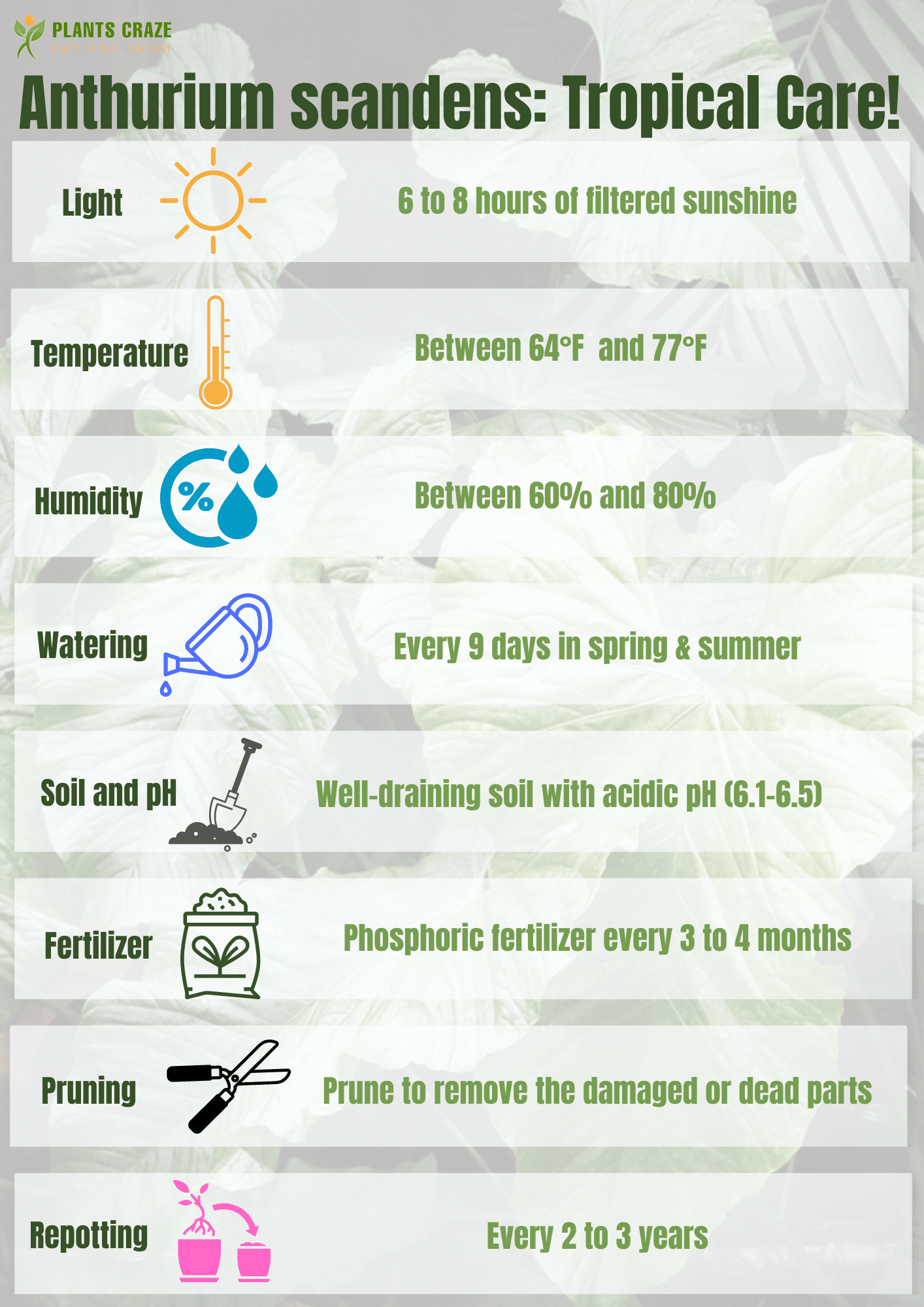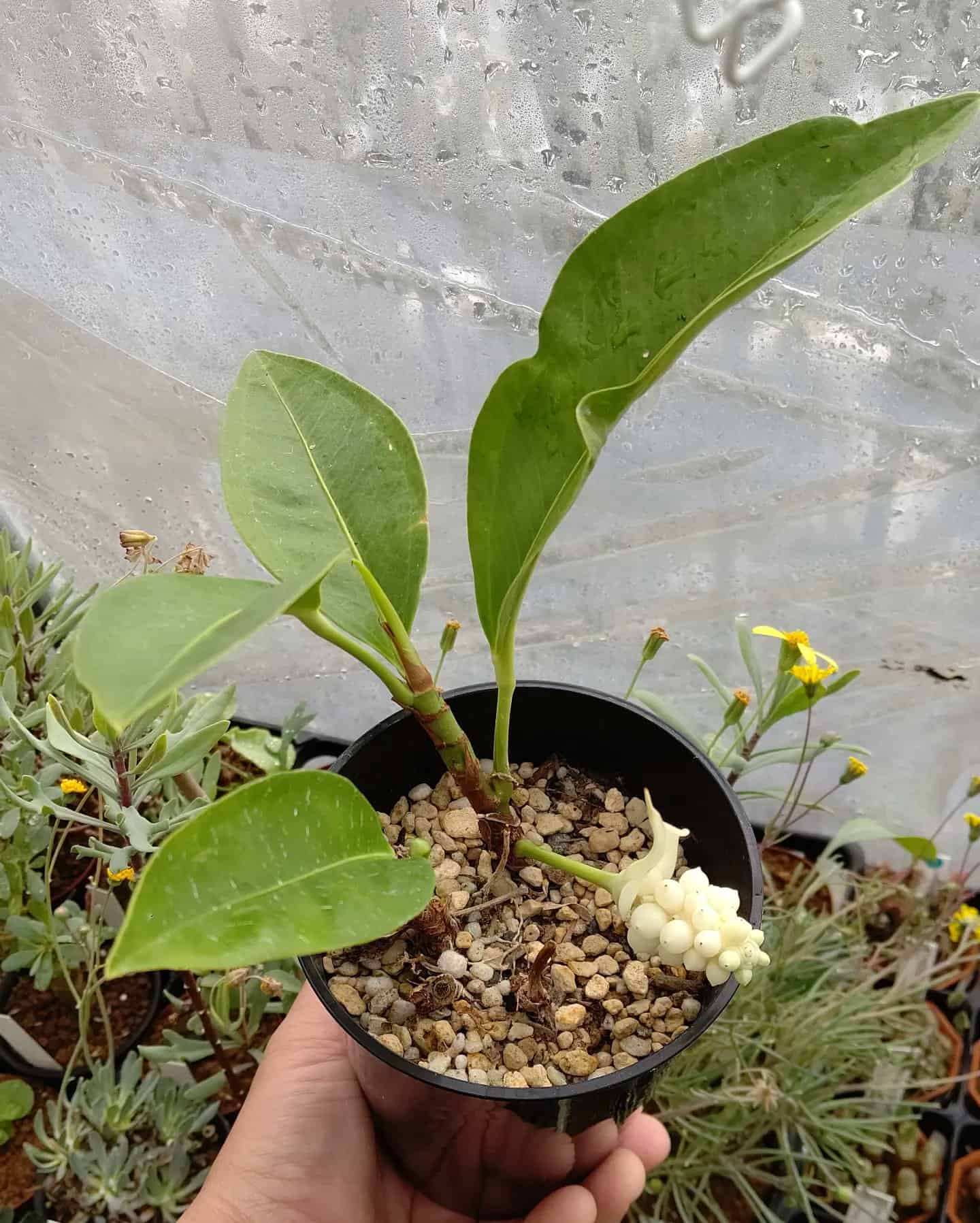Anthurium Scandens represents a terrarium plant that can survive in sealed-glass containers under little care!
Although the care seems similar to other Anthuriums, do not miss out on Scandens, for they give never-ending blooms an entire year.
Follow the article till the end to bring the Anthurium Scandens home and maintain optimum health.
Table of Contents Show
Overview of Anthurium Scandens
The Scandens species of Anthurium originated from Costa Rica, flourishing its roots from Southern Mexico to Southern Brazil.
| Features | Details |
|---|---|
| Family | Araceae |
| Genus | Anthurium |
| Species | Scandens |
| Common Names | Pearl laceleaf, Anthurium dolosum, Anthurium leucocarpum, Grape Anthurium |
| Foliage | Green glossy evergreen foliages Size: 6-13 cm Shape: Oval and elliptical |
| Flowering Period | All-year-round in the interval of 2-3 months |
| Fruits | White purplish berries |
| Plant Type | Creeping Ephyptic plant |
| Growth Habits | Scandens take three years to reach maturity |
| USDA Growth Zones | 10b-11 |
| Toxicity | Highly toxic Toxic to cats, dogs and humans |
| Common Pests | Mealybugs, Scales, Aphids, Thrips and Spider mites |
| Horticultural Diseases | Bacterial Blight, Bacterial Wilt, Leaf Spot, Black Nose Disease, Pythium (Phytophthora) Root Rot, and Rhizoctonia Root Rot |
Anthurium Scandens – A Complete Care Guide
The epiphytic perennial Anthurium Scandens demands minimal care to flourish its tropical leaves.

Indulge in detailed tips to care for your Anthurium Plants after this little capsule of gardening advice!
1. Sunlight & Temperature
Anthurium Scandens flourishes in a warm room (64-77°F) lightened with bright indirect sunlight.
This Anthurium grows and adapts fine outdoors in 10b-11 USDA zones. But protect them from the direct sun and cold frosts.
Direct sunlight and extreme heat can dehydrate the plant resulting in scorched, dry, brittle yellow leaves.
Conversely, low light and temperatures < 50°F suppress plants’ growth resulting in leggy, sparse foliage growth.
Thus, aim for incandescent lights, heat pads, frost blankets, or sheer drapes to keep Anthurium Scandens safe and warm.
2. Watering & Humidity
Anthurium Scandens do not fuss if you are keeping the soil slightly moist and their leaves dewy.
Like Anthurium Watermaliense, Scandens also stay dormant in winter. Thus, cut back on misting and watering in winter to avoid drowning.
Overwatered Anthurium shows signs like yellowing and limping alongside soggy, moldy soil. It also risks pest issues and fungal disease infections.
However, no water and humidity < 40% results in curling, droopy leaves with grayish, shrunken soil.
Thus, opt for the failsafe saucer watering method by adding a few pebbles. Also, regularly mist and gather plants like Areca palm to ensure optimum humidity.
3. Soil & Fertilizer
As Anthurium Scandens require regular watering, you must choose nutrient-rich soil with well-drainage.
Low to no fertilization can stunt plant growth resulting in smaller leaves, discoloration, and fewer blooms.
Prepare an organic soil mix using orchid bark, peat moss, perlite, and compost to avoid chemical burns.

Too much fertilizer accumulation in the soil can burn the roots and result in curling leaf tips and brown spots.
So, cut back on fertilizing your Scandens in winter to avoid overfertilization.
4. Potting & Repotting
Anthurium Scandens love to be bound to the same pot for their entire life, as they are tuberous.
So choose at least 5 inches pot at the beginning of potting to free yourself from the burden of repotting.
But you can wait a while before repotting if there is loosened soil and perform repotting in two to three years.
While repotting, choose at least 2 to 3 inches wider and bigger pot and fill it with a well-draining potting mix rich in organic matter.
Better to perform the repotting during drier months, from early to late spring, to prevent stressing the Scandens.
5. Occasional Pruning
Anthurium Scandens easily get attacked by pests that form colonies underneath the leaves.
The most common pest attacking Scandens are scale insects, thrips, and vine weevils.
They feed on the blossoms and transfer the necrotic virus to other plants with rapid munching on the leaves.
So treat these pests with insecticidal soap or neem oil. You can also trim the damaged part with sterilized scissors or pruning shears.
Also, they can outgrow the pot and become a host of diseases like powdery mildew, leaf spots, and root rot.
The affected plant shows a greyish and whitish powdery substance at the bottom of the plants, and a rotten smell comes from the roots with a brown spot on the leaves.
To treat the diseased part, spray the plant with copper-rich fungicides.
Anthurium Scandens: All About Growth Rate
The Scandens species of Anthurium have slow to moderate growth with year-long blooming from spring, summer, and fall.
Interestingly, you can enjoy the small, pale green flamingo blooms about 2 to 5 times a year, giving out the best from a slow creeper.
After completing the blooming period in about three months, the Scandens develop clusters of purple to white berries, giving out the look of pearls.

The glossy, oblong to elongated shaped foliage emerges from a thin, brown stem having a width of about 6 cm.
Toxicity of Anthurium Scandens
The harmful insoluble calcium oxalate crystal is present in every part of the plant so, ingestion of any part is dangerous.
Hypersalivation, mouth irritation, vomiting, and frequent pawing are the signs of Anthurium poisoning.
Consumption of Scandens in large amounts can result in kidney failure.
To lower the burning sensation in the mouth, you can give them milk as first aid. If your pet has breathing difficulty, immediately take them to the vet.
You can rely on these hotlines if you suspect your pets or kids took a nibble out of the plant.
Thus, strategically place the plant away from curious pets and kids’ reach.
Though Anthurium Scandens won’t harm or trigger any irritation from skin contact, it is advised to wear gloves while handling the plant.
Propagation Methods for Anthurium Scandens
Better to be clear that propagation not only multiplies the numbers but sometimes enhances growth and promotes blooms.
Here, you can learn to propagate the Anthurium Scandens using rhizomes, seeds, and tubers.
1. Propagation via Rhizomes
The bulb-like fleshy root rhizomes grow horizontally, along the trails and near the soil surface.
Follow the steps to divide them during the spring or fall.
- Start by watering the plant a day before dividing it to loosen up the soil.
- Next day, use a spade to mark the root ball and remove them from the soil without hurting the main system.
- Then, wash off the excess soil from the roots to have a clear vision of rhizomes.
- Now, be ready to split the root balls into half from the middle, leaving the stem and branches attached.
- Again, split off the detached rhizomes into small plant sections.
- But remember to stay within the number of splits, as the main root should not lose more than one-third of its diameter.
- Then, prepare the pots according to the division you have made and fill them with an organic potting mix or soil composition as mentioned above.
- Lastly, place the pot in a bright, warm spot for optimum growth.
You can even cover the pot with plastic containing small holes for higher humid conditions.
2. Propagation via Tuber Cuttings
Tubers in Anthurium Scandens are the main underground stem containing nodes you can find alongside the rhizomes.
Perform the propagation from tubers mainly in the spring, their active growing season.
- Start by pulling off the roots from the ground.
- Then, cut off the tubers into two to four inches long pieces leaving behind at least two nodes in each cutting.
- Check and remove the old and diseased tubers to promote only healthy growth.
- Next, plant each segment of tuber at most half the length deep in the peat-based organic potting mix.
- Make sure the growing bud faces upward and near the soil surface.
- Lastly, provide the ideal growing condition for the new Scandens to grow further in about 4-6 weeks.
3. Propagation via Seeds
Propagation from seed is time-consuming and takes about 4-6 weeks to germinate.
Start by collecting the seeds from the market or the blooms of previous growth.
- Fill a seedling tray or pot with damp moss. Peat moss works best for Anthuriums.
- Sow the seeds in a row and press them slightly inside the peat.
- Cover the tray or pot with plastic containing holes to promote humidity.
- Also, provide the seeds warmth by placing a heating mat beneath the tray and ample bright light for the first three weeks.
After about 2-3 months, you can transfer the seedlings to a new pot.
Learn more about the seed propagation of Anthurium through the video below!
Anthurium Scandens for Sale
After knowing the ultimate care of Anthurium Scandens, you are ready to bring new plants home.
Look out for the sites below to buy Scandens.
| Shops | Shipping Time |
|---|---|
| Peace Love and Happiness | Within 24 hours |
| Cheyd Plant Lady | 2 days after placing order |
| Rare Palm Seeds | Within 9 days of placing order |
| Etsy | 3 to 5 days of placing order |
If you wish to live around the Anthurium Plants, choose and invite one of the 20+ Anthurium varieties.
From Editorial Team
Cut off Spent Anthurium Scandens Flowers to Promote More Growth
Once the blooms die, deadhead them using sterilized shears. This helps free up the available nutrients for the rest of the plant and promotes the healthy growth of foliage.
Cut the Anthurium Plant down to the place where the flower stem develops from the main stem.


